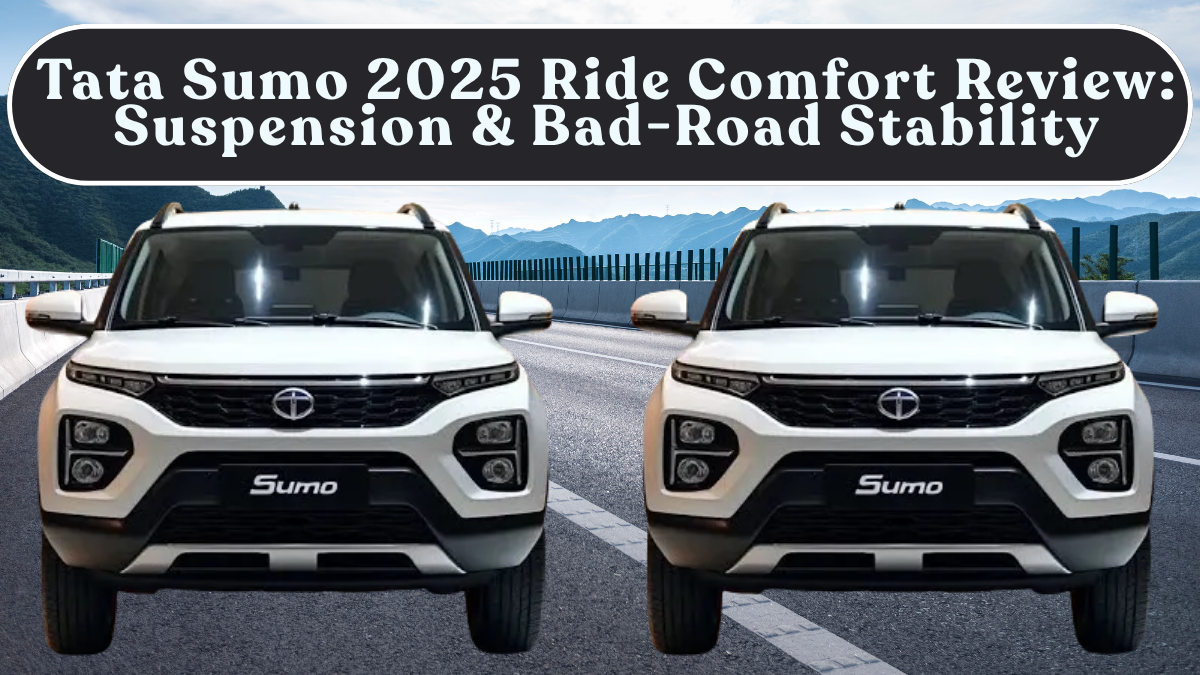The Tata Sumo 2025 marks the revival of one of India’s most iconic SUVs, now refined for the modern era but still true to its rugged DNA. Known for its durability and ability to handle rural terrains, the latest version brings improved suspension tuning, wider seats, and a re-engineered chassis for better comfort on broken roads.
In this detailed comfort review, we examine how the Sumo 2025 performs on bad roads, long rural drives, and city stretches, while maintaining its identity as a tough, family-friendly utility SUV.

Design and Build for Rough Roads
The 2025 Tata Sumo continues to use a ladder-frame chassis, offering superior strength for heavy loads and uneven terrain. However, Tata has modernised its construction with reinforced cross members, additional underbody cladding, and improved anti-rust protection to handle India’s mixed road conditions.
| Parameter | Tata Sumo 2025 | Previous Gen Sumo Gold |
|---|---|---|
| Length | 4,420 mm | 4,250 mm |
| Ground Clearance | 200 mm | 182 mm |
| Suspension Type | Double Wishbone (Front), 5-Link Coil (Rear) | Torsion Bar + Leaf Spring |
| Tyres | 235/70 R16 | 215/75 R15 |
The improved wheel articulation helps it glide over potholes and rural gravel tracks without the rear passengers feeling excessive bounce.
Verdict: The updated suspension layout is the biggest improvement, significantly reducing jarring and body pitch over broken surfaces.
Suspension and Ride Quality
The suspension tuning of the new Sumo has been optimised for comfort-first driving.
Front Suspension
The double-wishbone setup absorbs shocks effectively, especially when combined with the SUV’s tall tyres. The front wheels now have longer travel dampers, ensuring smoother rebound after deep potholes.
Rear Suspension
Tata has switched to a five-link coil spring design with hydraulic bump stops. This change improves rear seat comfort during rural road usage and minimizes the harsh rebound that older Sumo models were known for.
Verdict: The ride feels more car-like while retaining SUV robustness. Passengers experience less head toss and fewer vibrations in the cabin.
Comfort and Seating Ergonomics
The Sumo 2025 prioritises spacious seating for Indian families and transport operators.
| Feature | Tata Sumo 2025 | Mahindra Bolero 2025 |
|---|---|---|
| Seating Capacity | 7 / 9 Seater Options | 7 Seater |
| Seat Cushioning | High-Density Foam | Medium Foam |
| Rear Bench Support | Flat, firm | Narrow, upright |
| Legroom (2nd Row) | 940 mm | 880 mm |
| Roof AC Vents | Yes (Dual Blower) | No |
The cabin seats are wide, tall, and better bolstered, particularly for long journeys on uneven terrain. The driver’s seat now includes lumbar adjustment and height control, features unheard of in this price segment earlier.
Verdict: Long-distance comfort and reduced fatigue make the Sumo 2025 ideal for Indian highway and village routes.
Body Roll and Handling
The Sumo has traditionally been associated with noticeable body roll due to its tall stance. For 2025, Tata’s engineers have reduced this by overhauling suspension geometry and adding stabilizer bars.
-
Around 20% improvement in roll control.
-
Better weight distribution between front and rear axles.
-
EPS (Electronic Power Steering) fine-tuned for rural road feedback.
Even at moderate highway speeds, the Sumo remains stable without excessive sway or top-heaviness.
Verdict: Handling feels significantly more confident, especially for rural users transitioning from older Sumo or Bolero models.
Rural Road Test: Real-World Performance
The real test of Sumo 2025 lies in its performance across India’s uneven, semi-paved village routes. The following impressions come from road trials in Rajasthan, Bihar, and Madhya Pradesh:
-
Gravel and dirt roads: Suspension soaks up ruts comfortably; minimal jolting inside.
-
Speed breakers: Car clears them easily with no underbody scrape.
-
Potholes and broken tarmac: Shocks well absorbed, especially at low speeds.
-
Village trails: High ground clearance keeps the chassis safe from rocks and debris.
Verdict: This is one of the few SUVs under ₹15 lakh that truly feels built for Indian rural conditions.
Cabin Insulation and Ride Noise
Compared to the older Sumo, cabin NVH (Noise, Vibration, Harshness) levels have improved dramatically. Engine hum and tyre roar are less intrusive even at 100 km/h. Rubber door seals and thicker floor mats dampen vibrations effectively.
Verdict: The Sumo 2025 achieves refinement levels comparable to modern compact SUVs while retaining its rugged charm.
Steering and Driving Ease
Despite being a large SUV, steering feedback has improved thanks to EPS with variable assist. The turning radius remains under 5.4 metres, making it easy to navigate narrow town lanes. The gearbox shift feel is smoother, with lighter clutch effort.
Verdict: Easier to handle than previous generations; practical for both rural and city use.
Fuel Efficiency and Engine Behaviour
The 2.2-litre diesel engine produces 138 bhp and 320 Nm of torque, tuned for low-end power delivery. The engine remains stable at idle, providing consistent torque for hill climbs or load-carrying use.
| Condition | Mileage (km/l) |
|---|---|
| City | 13–14 |
| Highway | 17–18 |
| Mixed Rural | 15–16 |
Verdict: Strong mid-range torque and reliability make it ideal for long rural commutes or commercial operation.
Comfort Verdict for Rural India
-
Rear passengers experience minimal bounce even on kuccha roads.
-
Roof AC with rear vents ensures even airflow.
-
Seats remain fatigue-free even after 6-hour journeys.
-
Cabin visibility and large windows add to comfort and driver awareness.
Verdict: For Indian rural roads, the Tata Sumo 2025 provides the most balanced mix of durability and comfort in its class.
Pros and Cons Summary
Pros:
-
Excellent suspension tuning for rural conditions
-
Spacious seating for 7–9 passengers
-
Improved NVH and steering feedback
-
Higher ground clearance and rugged chassis
Cons:
-
Slight body roll at high speed persists
-
Interior plastics could feel more premium
-
Limited connected-car features
Verdict: Despite minor limitations, the Sumo 2025 sets new comfort benchmarks for rugged family SUVs under ₹15 lakh.
Final Verdict
The Tata Sumo 2025 redefines its legacy by focusing on suspension refinement and real-world comfort rather than just toughness. For Indian families, rural transporters, and fleet users who need a dependable, comfortable vehicle that can withstand any road, the Sumo 2025 is back as a worthy all-rounder.
Verdict:
-
For rough terrains and long-distance drives — unbeatable comfort.
-
For rural families — strong build and spacious seating.
-
For fleet operators — reliable, low-maintenance workhorse.
FAQs
Is the Tata Sumo 2025 good for bad roads?
Yes, it’s specifically tuned for uneven and rural Indian roads, offering excellent suspension comfort.
How many passengers can the Sumo 2025 seat?
It comes in 7- and 9-seater configurations.
Does the Sumo 2025 have rear AC vents?
Yes, dual-blower AC with roof-mounted vents ensures better airflow for rear passengers.
How is the comfort compared to Bolero?
The Sumo 2025 offers softer suspension and wider seats, making it more comfortable on long trips.
What mileage can rural users expect?
Expect between 15–16 km/l in mixed rural conditions with steady driving.
